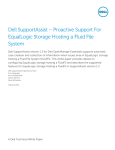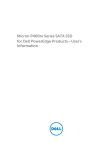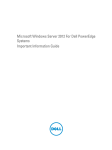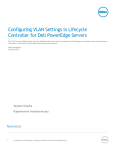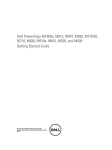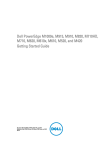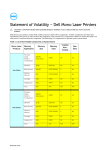Download Dell Lifecycle Controller 2 Version 1.3.0 Operation Manual
Transcript
Performing a Break-Mirror Operation Using Lifecycle Controller This Dell Technical White Paper provides the procedure to perform Break-Mirror operation using Lifecycle Controller on the 12th Generation servers and later of Dell. Dell Engineering November 2013 Aruna Jayaprakash Balaji K Bala Gupta Vinod P S Sheshadri P.R. Rao A Dell Technical White Paper Revisions Date Description Nov 2013 Initial release THIS WHITE PAPER IS FOR INFORMATIONAL PURPOSES ONLY, AND MAY CONTAIN TYPOGRAPHICAL ERRORS AND TECHNICAL INACCURACIES. THE CONTENT IS PROVIDED AS IS, WITHOUT EXPRESS OR IMPLIED WARRANTIES OF ANY KIND. © 2013 Dell Inc. All rights reserved. Reproduction of this material in any manner whatsoever without the express written permission of Dell Inc. is strictly forbidden. For more information, contact Dell. Dell, the DELL logo, and the DELL badge are trademarks of Dell Inc. Symantec, NetBackup, and Backup Exec are trademarks of Symantec Corporation in the U.S. and other countries. Microsoft, Windows, and Windows Server are registered trademarks of Microsoft Corporation in the United States and/or other countries. Other trademarks and trade names may be used in this document to refer to either the entities claiming the marks and names or their products. Dell disclaims any proprietary interest in the marks and names of others. Trademarks used in this text: Dell™, the Dell logo, Dell Boomi™, Dell Precision™ ,OptiPlex™, Latitude™, PowerEdge™, PowerVault™, PowerConnect™, OpenManage™, EqualLogic™, Compellent™, KACE™, FlexAddress™, Force10™ and Vostro™ are trademarks of Dell Inc. Other Dell trademarks may be used in this document. Cisco Nexus®, Cisco MDS®, Cisco NX0S®, and other Cisco Catalyst® are registered trademarks of Cisco System Inc. EMC VNX®, and EMC Unisphere® are registered trademarks of EMC Corporation. Intel®, Pentium®, Xeon®, Core® and Celeron® are registered trademarks of Intel Corporation in the U.S. and other countries. AMD® is a registered trademark and AMD Opteron™, AMD Phenom™ and AMD Sempron™ are trademarks of Advanced Micro Devices, Inc. Microsoft®, Windows®, Windows Server®, Internet Explorer®, MS-DOS®, Windows Vista® and Active Directory® are either trademarks or registered trademarks of Microsoft Corporation in the United States and/or other countries. Red Hat® and Red Hat® Enterprise Linux® are registered trademarks of Red Hat, Inc. in the United States and/or other countries. Novell® and SUSE® are registered trademarks of Novell Inc. in the United States and other countries. Oracle® is a registered trademark of Oracle Corporation and/or its affiliates. Citrix®, Xen®, XenServer® and XenMotion® are either registered trademarks or trademarks of Citrix Systems, Inc. in the United States and/or other countries. VMware®, Virtual SMP®, vMotion®, 2 Performing a Break-Mirror Operation Using Lifecycle Controller vCenter® and vSphere® are registered trademarks or trademarks of VMware, Inc. in the United States or other countries. IBM® is a registered trademark of International Business Machines Corporation. Broadcom® and NetXtreme® are registered trademarks of Broadcom Corporation. Qlogic is a registered trademark of QLogic Corporation. Other trademarks and trade names may be used in this document to refer to either the entities claiming the marks and/or names or their products and are the property of their respective owners. Dell disclaims proprietary interest in the marks and names of others. 3 Performing a Break-Mirror Operation Using Lifecycle Controller Contents Revisions ..................................................................................................................................................................................................2 Executive Summary ...............................................................................................................................................................................5 Introduction ............................................................................................................................................................................................5 Performing Break-Mirror Operation Using Lifecycle Controller ................................................................................................ 6 Pre-requisites........................................................................................................................................................................................14 4 Performing a Break-Mirror Operation Using Lifecycle Controller Executive Summary This whitepaper provides the procedure to perform Break-Mirror operation using Lifecycle Controller on the 12th generation servers and later of Dell. Introduction Break-Mirror is a feature in the Lifecycle Controller of the 12th generation servers and later of Dell that is used to replicate the data from one server to another by safely breaking or isolating a RAID1 virtual disk. This feature enables easy operation by providing an intuitive, user-friendly graphical user interface (GUI). Figure 1 5 The Break-Mirror Page Performing a Break-Mirror Operation Using Lifecycle Controller Performing Break-Mirror Operation Using Lifecycle Controller 1. To start Lifecycle Controller, press <F10> during POST. 2. In the left pane, click Hardware Configuration. Figure 2 6 Lifecycle Controller Home page Performing a Break-Mirror Operation Using Lifecycle Controller 3. In the left pane, click Hardware Configuration, and then click Configuration Wizards. Figure 3 7 Hardware Configuration Performing a Break-Mirror Operation Using Lifecycle Controller 4. On the Hardware Configuration: Configuration Wizards page, click Break Mirror. Figure 4 8 Configuration Wizards Performing a Break-Mirror Operation Using Lifecycle Controller 5. On the Break Mirror page, a list of all the virtual disks that are RAID1 break-mirror—capable is displayed. In the Controller column, select the option corresponding to the virtual disk on which you want to apply the break-mirror feature, and then click Finish. Figure 5 9 Break Mirror Performing a Break-Mirror Operation Using Lifecycle Controller After the break-mirror operation is successfully completed, a message is displayed to indicate that the server will be automatically turned off. 6. Click Yes. Figure 6 Break Mirror Confirmation The break-mirror operation is completed successfully, and the LEDs corresponding to the HDDs start blinking. 10 Performing a Break-Mirror Operation Using Lifecycle Controller 7. Click Shut down. 8. Wait for the server to automatically turn off, remove the HDDs, and then turn on the server. Figure 7 11 Break Mirror Confirmation Performing a Break-Mirror Operation Using Lifecycle Controller When you restart the server, Power-On-Self-Test (POST) indicates the status (of those virtual disks on which the break-mirror operation was performed) as Degraded Virtual Disk. The broken virtual disks are identified as Degraded. Figure 8 12 Degraded Virtual Disk Performing a Break-Mirror Operation Using Lifecycle Controller On the Raid Configuration page of Lifecycle Controller, these virtual disks are indicated as Degraded (in the State column). Figure 9 13 Degraded Virtual Disk in LC UI Performing a Break-Mirror Operation Using Lifecycle Controller Pre-requisites 1. Break-Mirror operation can be performed only on RAID1 virtual disks. 2. System must have atleast one RAID1 virtual disk to enable the Break-Mirror feature. Figure 10 Break-Mirror Disabled–1 Figure 11 Break-Mirror Disabled–2 14 Performing a Break-Mirror Operation Using Lifecycle Controller Notes: The time required to complete a Break-Mirror operation varies on the basis of number of virtual disk(s) selected for the Break Mirror operation. A Break-Mirror operation is not allowed when the initialization of virtual disk is in progress in the back-end. The Time required to complete the Background initialization process varies on the basis of size of the virtual disk. If the memory capacity of the virtual disk is higher, then longer duration is required to complete the background initialization of the virtual disk. Figure 12 An Unsuccessfully Completed Break-Mirror Operation 15 Performing a Break-Mirror Operation Using Lifecycle Controller















